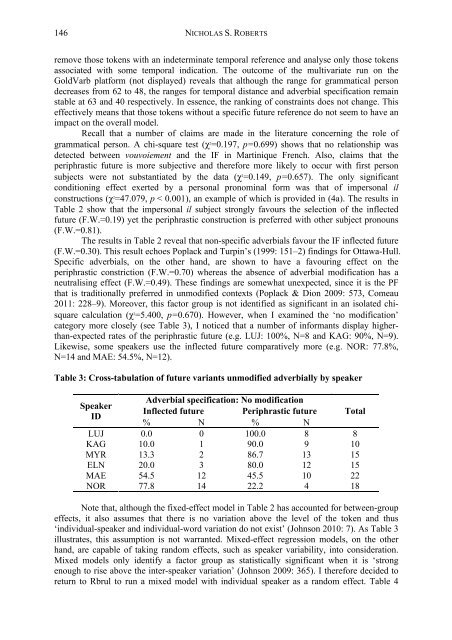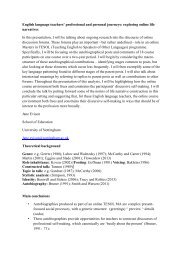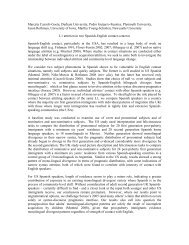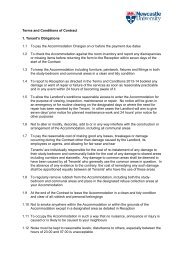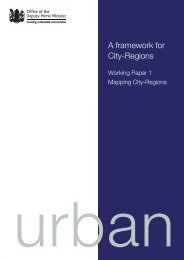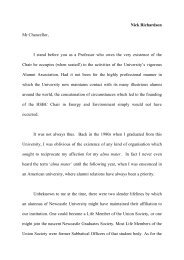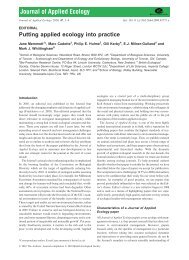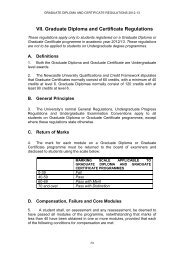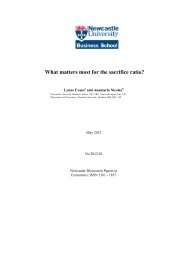the influence of linguistic factors on the expression of futurity
the influence of linguistic factors on the expression of futurity
the influence of linguistic factors on the expression of futurity
Create successful ePaper yourself
Turn your PDF publications into a flip-book with our unique Google optimized e-Paper software.
146<br />
NICHOLAS S. ROBERTS<br />
remove those tokens with an indeterminate temporal reference and analyse <strong>on</strong>ly those tokens<br />
associated with some temporal indicati<strong>on</strong>. The outcome <str<strong>on</strong>g>of</str<strong>on</strong>g> <str<strong>on</strong>g>the</str<strong>on</strong>g> multivariate run <strong>on</strong> <str<strong>on</strong>g>the</str<strong>on</strong>g><br />
GoldVarb platform (not displayed) reveals that although <str<strong>on</strong>g>the</str<strong>on</strong>g> range for grammatical pers<strong>on</strong><br />
decreases from 62 to 48, <str<strong>on</strong>g>the</str<strong>on</strong>g> ranges for temporal distance and adverbial specificati<strong>on</strong> remain<br />
stable at 63 and 40 respectively. In essence, <str<strong>on</strong>g>the</str<strong>on</strong>g> ranking <str<strong>on</strong>g>of</str<strong>on</strong>g> c<strong>on</strong>straints does not change. This<br />
effectively means that those tokens without a specific future reference do not seem to have an<br />
impact <strong>on</strong> <str<strong>on</strong>g>the</str<strong>on</strong>g> overall model.<br />
Recall that a number <str<strong>on</strong>g>of</str<strong>on</strong>g> claims are made in <str<strong>on</strong>g>the</str<strong>on</strong>g> literature c<strong>on</strong>cerning <str<strong>on</strong>g>the</str<strong>on</strong>g> role <str<strong>on</strong>g>of</str<strong>on</strong>g><br />
grammatical pers<strong>on</strong>. A chi-square test (χ 2 =0.197, p=0.699) shows that no relati<strong>on</strong>ship was<br />
detected between vouvoiement and <str<strong>on</strong>g>the</str<strong>on</strong>g> IF in Martinique French. Also, claims that <str<strong>on</strong>g>the</str<strong>on</strong>g><br />
periphrastic future is more subjective and <str<strong>on</strong>g>the</str<strong>on</strong>g>refore more likely to occur with first pers<strong>on</strong><br />
subjects were not substantiated by <str<strong>on</strong>g>the</str<strong>on</strong>g> data (χ 2 =0.149, p=0.657). The <strong>on</strong>ly significant<br />
c<strong>on</strong>diti<strong>on</strong>ing effect exerted by a pers<strong>on</strong>al pr<strong>on</strong>ominal form was that <str<strong>on</strong>g>of</str<strong>on</strong>g> impers<strong>on</strong>al il<br />
c<strong>on</strong>structi<strong>on</strong>s (χ 2 =47.079, p < 0.001), an example <str<strong>on</strong>g>of</str<strong>on</strong>g> which is provided in (4a). The results in<br />
Table 2 show that <str<strong>on</strong>g>the</str<strong>on</strong>g> impers<strong>on</strong>al il subject str<strong>on</strong>gly favours <str<strong>on</strong>g>the</str<strong>on</strong>g> selecti<strong>on</strong> <str<strong>on</strong>g>of</str<strong>on</strong>g> <str<strong>on</strong>g>the</str<strong>on</strong>g> inflected<br />
future (F.W.=0.19) yet <str<strong>on</strong>g>the</str<strong>on</strong>g> periphrastic c<strong>on</strong>structi<strong>on</strong> is preferred with o<str<strong>on</strong>g>the</str<strong>on</strong>g>r subject pr<strong>on</strong>ouns<br />
(F.W.=0.81).<br />
The results in Table 2 reveal that n<strong>on</strong>-specific adverbials favour <str<strong>on</strong>g>the</str<strong>on</strong>g> IF inflected future<br />
(F.W.=0.30). This result echoes Poplack and Turpin’s (1999: 151–2) findings for Ottawa-Hull.<br />
Specific adverbials, <strong>on</strong> <str<strong>on</strong>g>the</str<strong>on</strong>g> o<str<strong>on</strong>g>the</str<strong>on</strong>g>r hand, are shown to have a favouring effect <strong>on</strong> <str<strong>on</strong>g>the</str<strong>on</strong>g><br />
periphrastic c<strong>on</strong>stricti<strong>on</strong> (F.W.=0.70) whereas <str<strong>on</strong>g>the</str<strong>on</strong>g> absence <str<strong>on</strong>g>of</str<strong>on</strong>g> adverbial modificati<strong>on</strong> has a<br />
neutralising effect (F.W.=0.49). These findings are somewhat unexpected, since it is <str<strong>on</strong>g>the</str<strong>on</strong>g> PF<br />
that is traditi<strong>on</strong>ally preferred in unmodified c<strong>on</strong>texts (Poplack & Di<strong>on</strong> 2009: 573, Comeau<br />
2011: 228–9). Moreover, this factor group is not identified as significant in an isolated chisquare<br />
calculati<strong>on</strong> (χ 2 =5.400, p=0.670). However, when I examined <str<strong>on</strong>g>the</str<strong>on</strong>g> ‘no modificati<strong>on</strong>’<br />
category more closely (see Table 3), I noticed that a number <str<strong>on</strong>g>of</str<strong>on</strong>g> informants display higherthan-expected<br />
rates <str<strong>on</strong>g>of</str<strong>on</strong>g> <str<strong>on</strong>g>the</str<strong>on</strong>g> periphrastic future (e.g. LUJ: 100%, N=8 and KAG: 90%, N=9).<br />
Likewise, some speakers use <str<strong>on</strong>g>the</str<strong>on</strong>g> inflected future comparatively more (e.g. NOR: 77.8%,<br />
N=14 and MAE: 54.5%, N=12).<br />
Table 3: Cross-tabulati<strong>on</strong> <str<strong>on</strong>g>of</str<strong>on</strong>g> future variants unmodified adverbially by speaker<br />
Adverbial specificati<strong>on</strong>: No modificati<strong>on</strong><br />
Speaker<br />
Inflected future Periphrastic future<br />
ID<br />
% N % N<br />
Total<br />
LUJ 0.0 0 100.0 8 8<br />
KAG 10.0 1 90.0 9 10<br />
MYR 13.3 2 86.7 13 15<br />
ELN 20.0 3 80.0 12 15<br />
MAE 54.5 12 45.5 10 22<br />
NOR 77.8 14 22.2 4 18<br />
Note that, although <str<strong>on</strong>g>the</str<strong>on</strong>g> fixed-effect model in Table 2 has accounted for between-group<br />
effects, it also assumes that <str<strong>on</strong>g>the</str<strong>on</strong>g>re is no variati<strong>on</strong> above <str<strong>on</strong>g>the</str<strong>on</strong>g> level <str<strong>on</strong>g>of</str<strong>on</strong>g> <str<strong>on</strong>g>the</str<strong>on</strong>g> token and thus<br />
‘individual-speaker and individual-word variati<strong>on</strong> do not exist’ (Johns<strong>on</strong> 2010: 7). As Table 3<br />
illustrates, this assumpti<strong>on</strong> is not warranted. Mixed-effect regressi<strong>on</strong> models, <strong>on</strong> <str<strong>on</strong>g>the</str<strong>on</strong>g> o<str<strong>on</strong>g>the</str<strong>on</strong>g>r<br />
hand, are capable <str<strong>on</strong>g>of</str<strong>on</strong>g> taking random effects, such as speaker variability, into c<strong>on</strong>siderati<strong>on</strong>.<br />
Mixed models <strong>on</strong>ly identify a factor group as statistically significant when it is ‘str<strong>on</strong>g<br />
enough to rise above <str<strong>on</strong>g>the</str<strong>on</strong>g> inter-speaker variati<strong>on</strong>’ (Johns<strong>on</strong> 2009: 365). I <str<strong>on</strong>g>the</str<strong>on</strong>g>refore decided to<br />
return to Rbrul to run a mixed model with individual speaker as a random effect. Table 4


